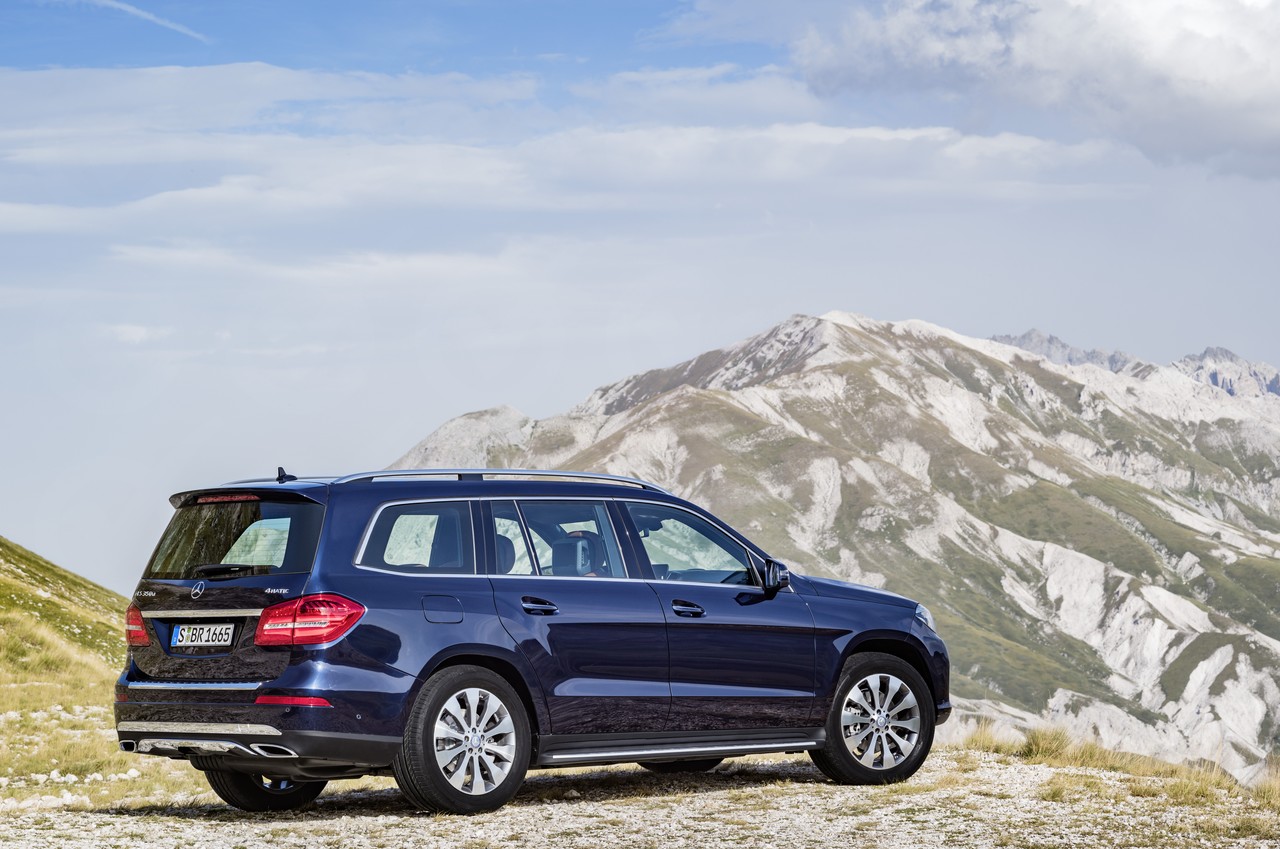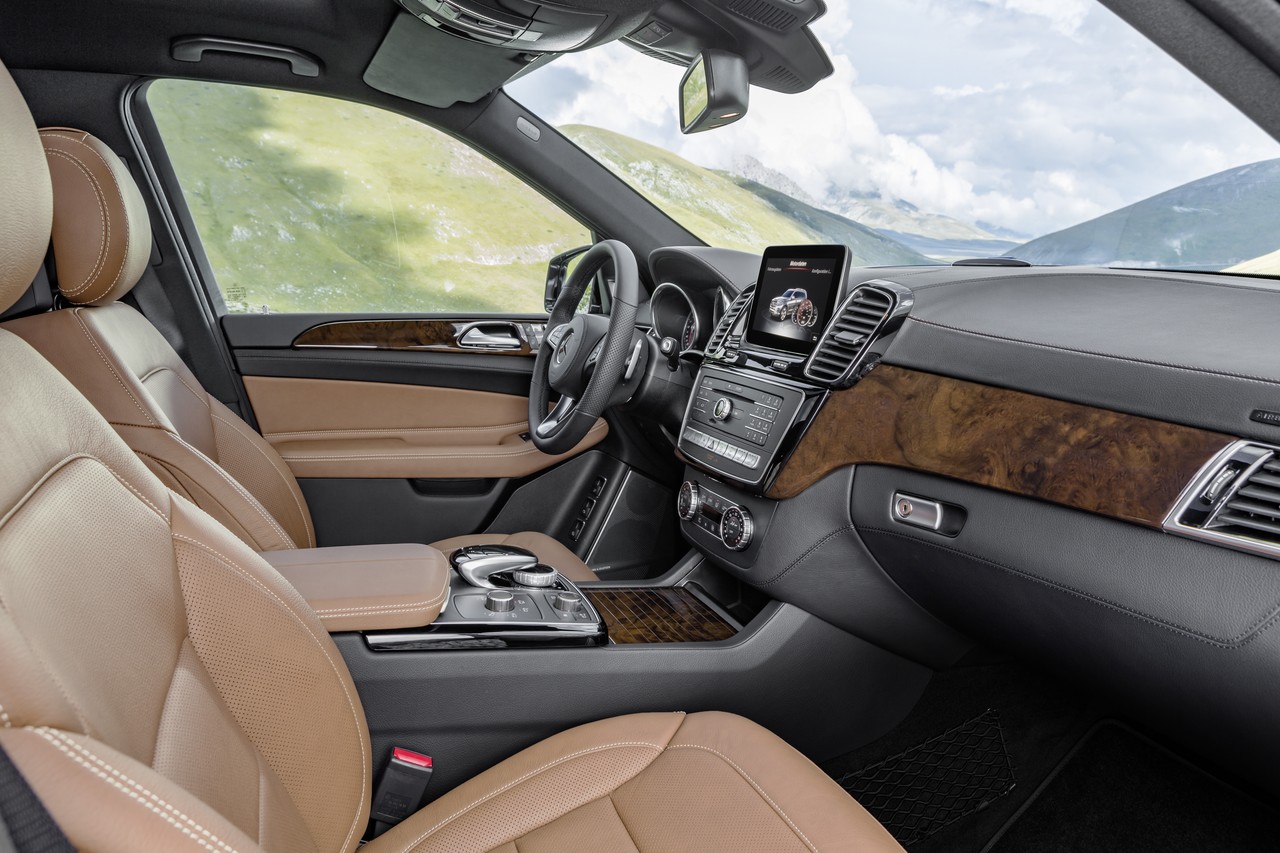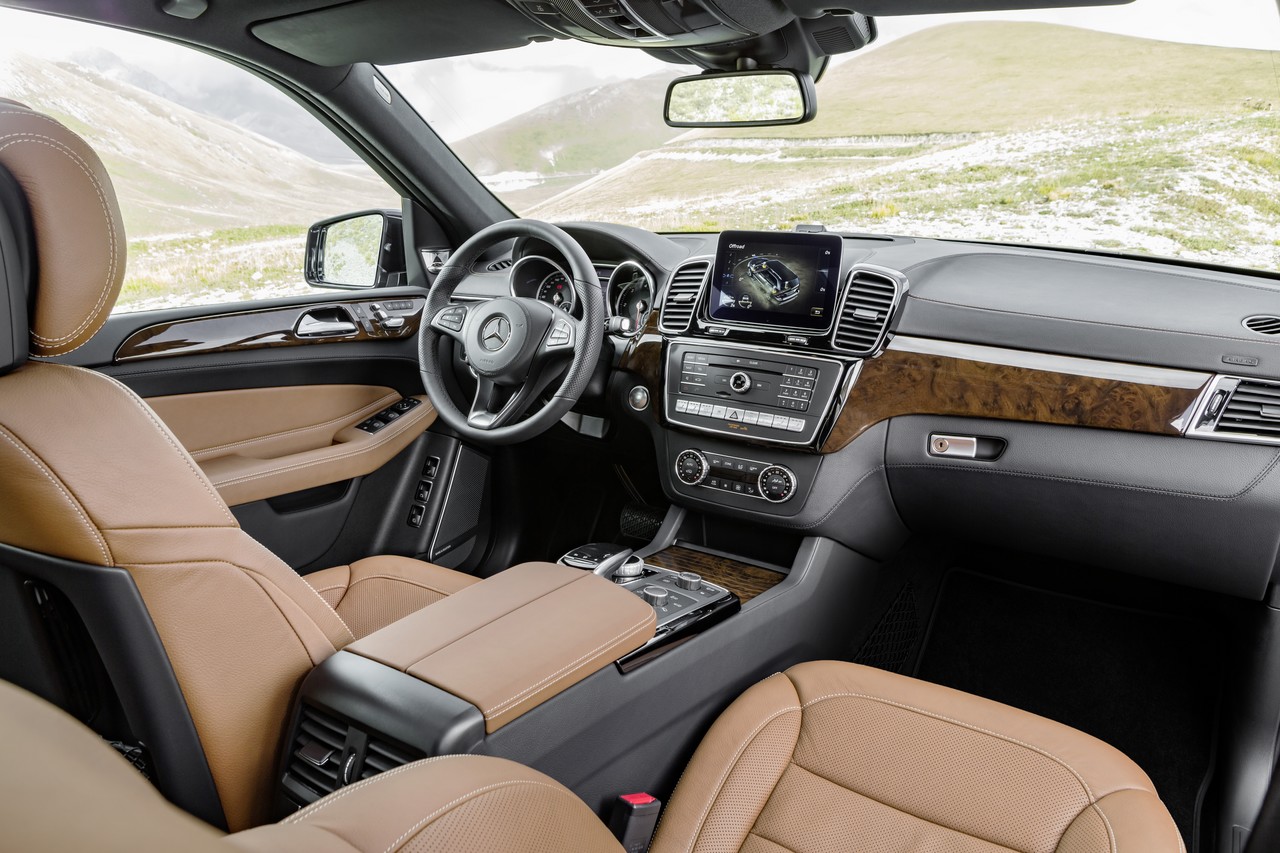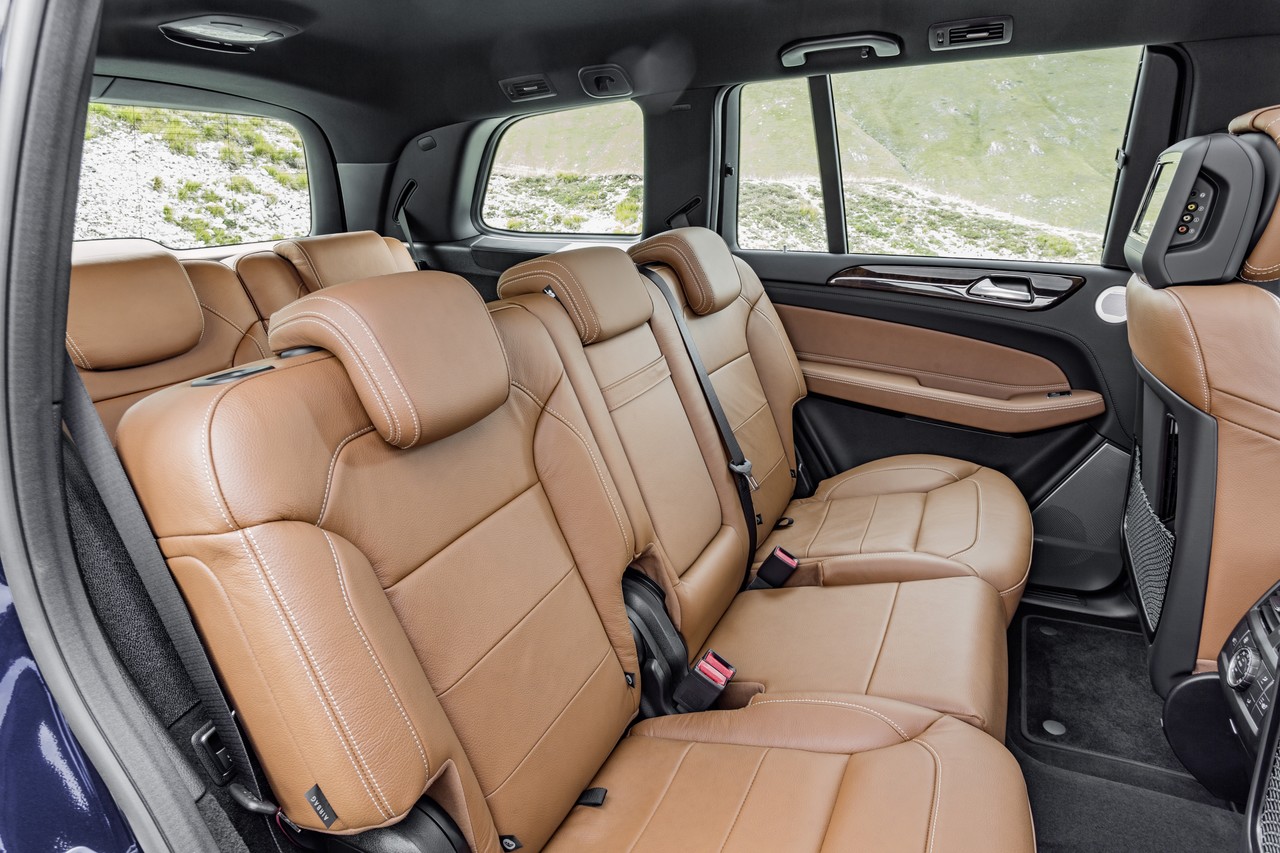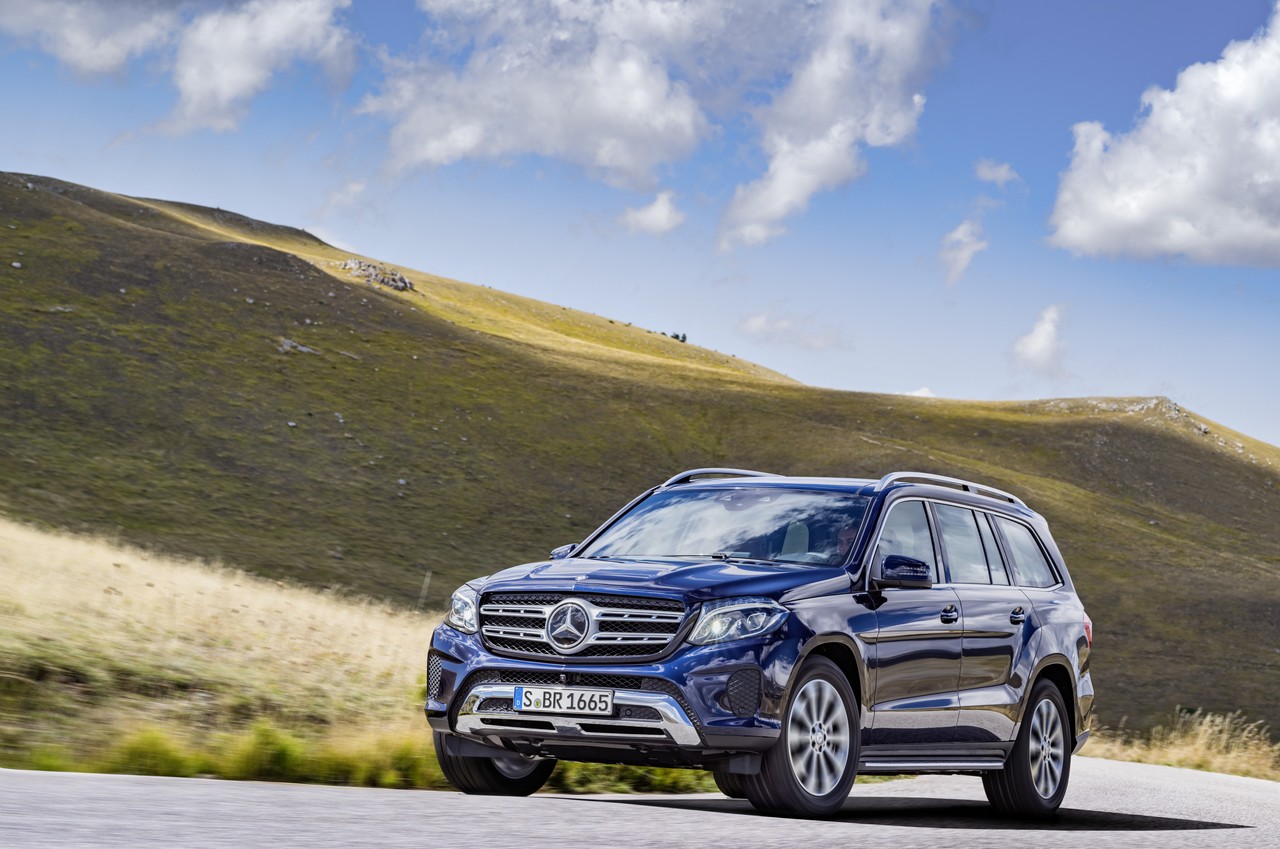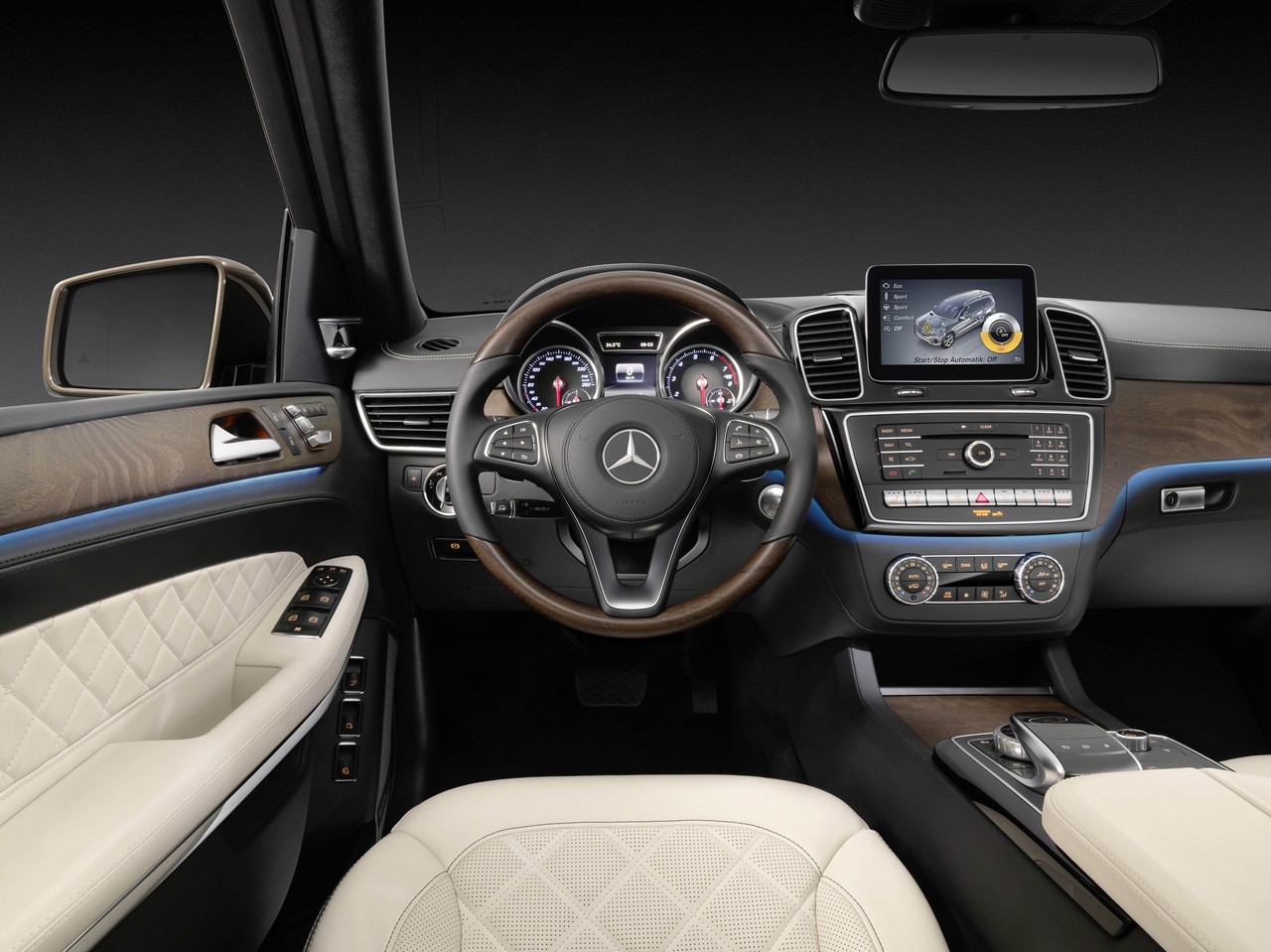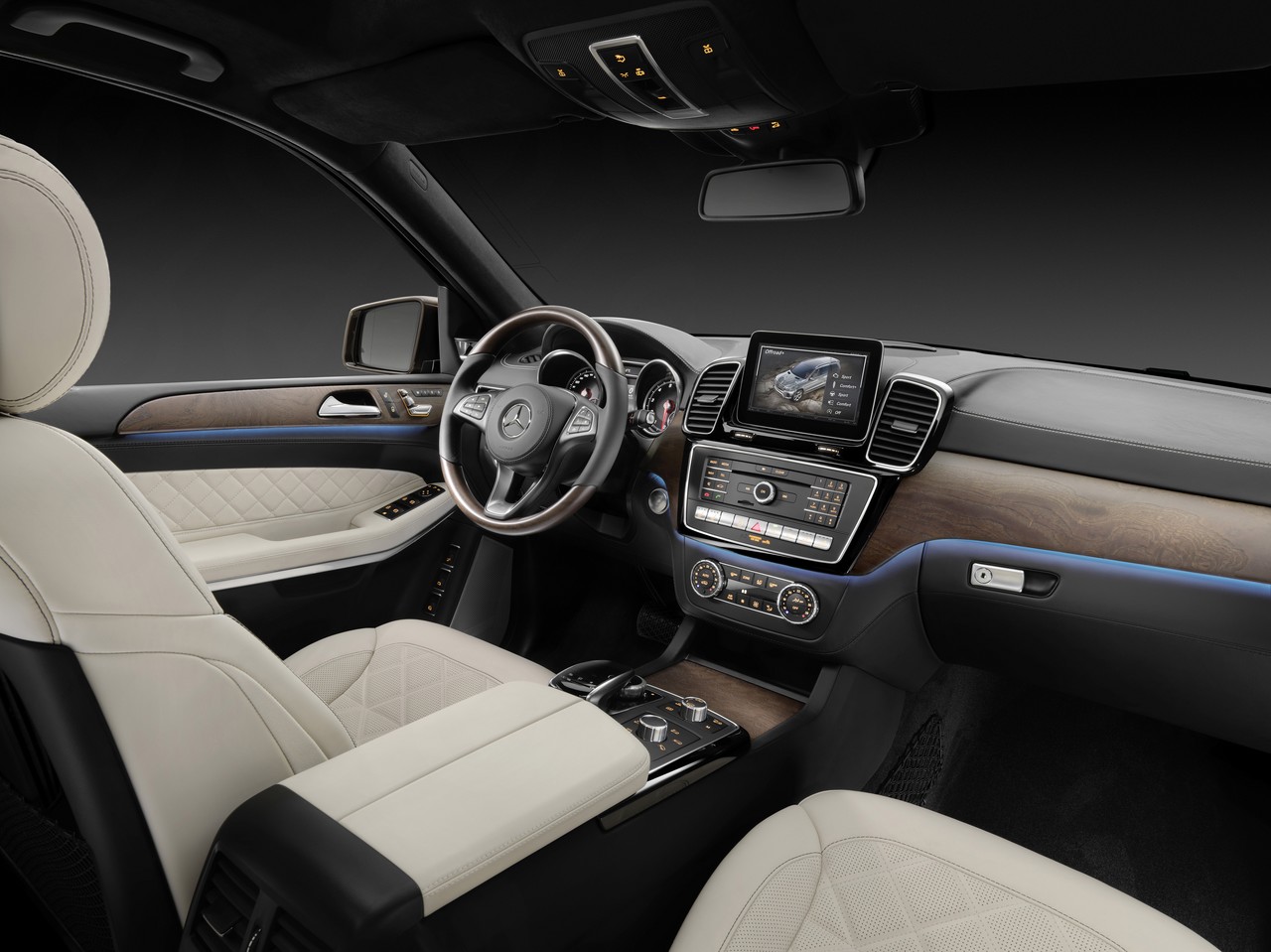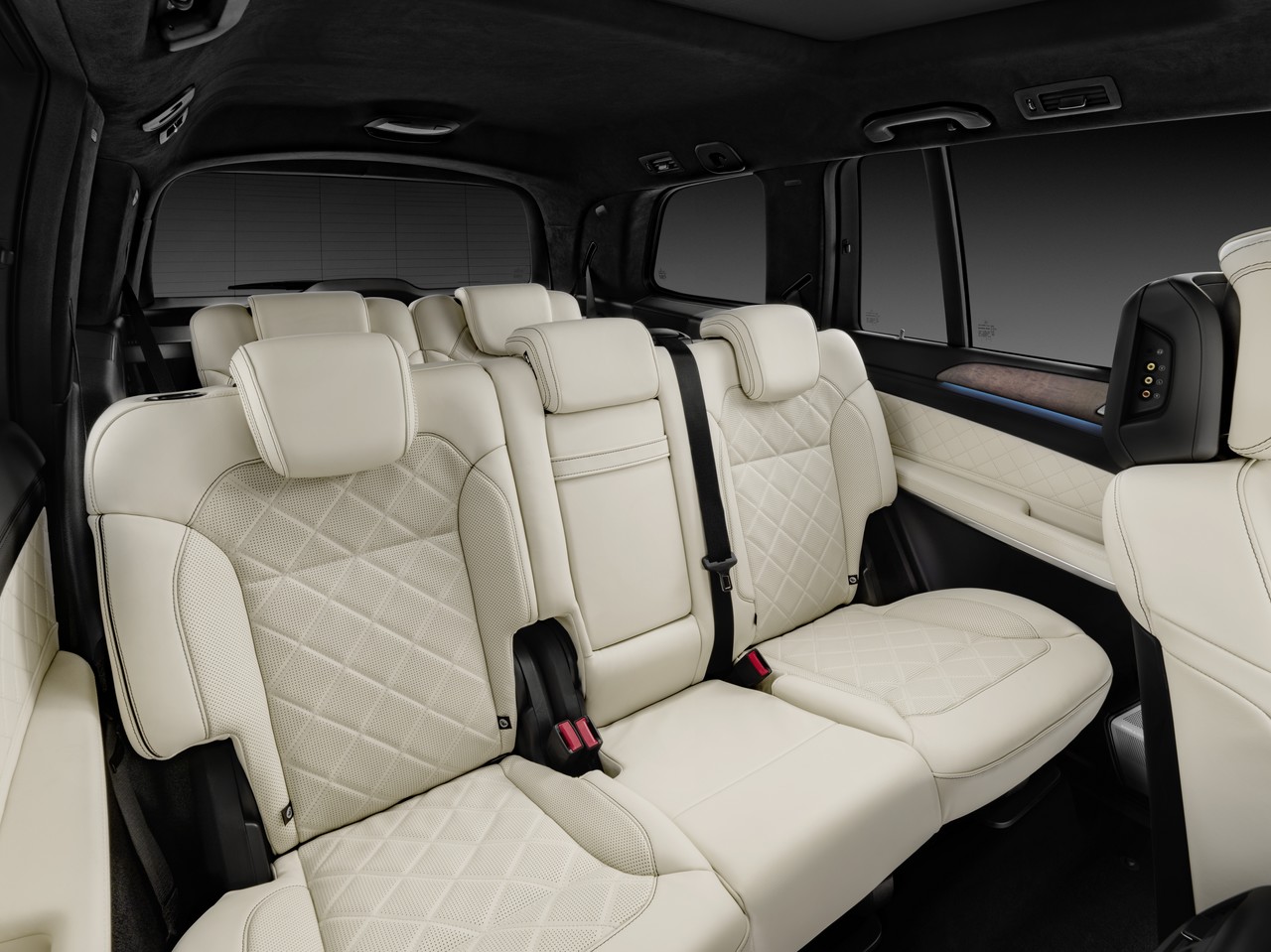
- Responsive and fuel-efficient turbo-diesel engines
- Comfortable ride and competent dynamics
- Spacious interior with usable third row seats
- Nine-speed automatic transmission reduces fuel consumption
- Artifically weighted steering lacks feel
- Brake pedal lacks initial response
Overview
Released in Australia in April 2016, the Mercedes-Benz X166 GLS-Class was a seven-seat, four-wheel drive wagon. Manufactured in Tuscaloosa, Alabama, the Mercedes-Benz GLS-Class effectively replaced the X166 GL-Class due to a change in Mercedes-Benz’s naming conventions. For Australia, GLS-Class range consisted of the GLS 350 d, GLS 350 d and GLS 500 models.
Please note that the related Mercedes-AMG X166 GLS 63 has been reviewed separately.
| Engine | Trans. | Peak power | Peak torque | |
|---|---|---|---|---|
| GL 350d | 3.0-litre OM642 turbo-diesel V6 | 9sp auto | 190 kW at 3600 rpm | 620 Nm at 1600-2400 rpm |
| GL 350d Sport | 3.0-litre OM642 turbo-diesel V6 | 9sp auto | 190 kW at 3600 rpm | 620 Nm at 1600-2400 rpm |
| GLS 500 | 4.6-litre M278 biturbo petrol V8 | 9sp auto | 335 kW at 5250-5750 rpm | 760 Nm at 1750-5000 rpm |
9G-Tronic transmission
The Mercedes-Benz X166 GLS-Class was fitted with Mercedes-Benz’s ‘9G-Tronic’ nine-speed automatic transmission. As an option, the transmission was available an off-road reduction gear and centre differential lock (the ‘Off-Road Engineering’ package). According to Mercedes-Benz, the transmission featured a new type of torque converter which achieved 92 per cent efficiency; the transmission also had a double turbine torsional damper with centrifugal pendulum and a torque converter lock-up clutch with return spring for ‘refined operation’.
For the GLS-Class, Mercedes-Benz’s ‘Dynamic Select’ system enabled the driver to select from Comfort, Slippery, Sport, Individual or Off-road transmission modes via a controller in the centre console. If equipped with the Off-Road Engineering package, an Off-Road+ mode could also be engaged.
4MATIC four-wheel drive
The Mercedes-Benz X166 GLS-Class was fitted with Mercedes-Benz’s ‘4MATIC’ four-wheel drive system – which provided a 50:50 front:rear torque split – and ‘4ETS’ traction control systems. Available as an option, the ‘Off-Road Engineering’ package included a centre differential lock, a two-stage transfer case with a low-range ratio, a protective underguard and an enhanced AIRMATIC system for maximum ground clearance of 306 mm and fording depth of 600 mm.
Dimensions
The Mercedes-Benz GLS-Class was 5130 mm long, 1934 mm wide (excluding door mirrors), 1850 mm tall and had a 3075 mm long wheelbase.
Airmatic suspension and Adaptive Damping System
The X166 GLS-Class had double wishbone front suspension and independent, multi-link rear suspension. The suspension included Mercedes-Benz’s ‘Airmatic’ air suspension with Adaptive Damping System (ADS) which consisted of:
- Air-filled spring struts on the front axle with integral ADS dampers;
- Air springs with separate ADS dampers on the rear axle;
- An electric compressor with central pressure reservoir and pressure sensor;
- Air spring valves;
- Sensors for level control and damping control; and,
- An electronic control unit.
The Airmatic air suspension could compensate for variations in vehicle load and driving state, while also acting as a level control system. For speeds above 70 km/h or when the ‘Sport plus’ mode was engaged, the air suspension would lower the body by 10 mm to reduce drag and increase stability. For off-road use, the air springs could increase ground clearance by up to 60 mm.
The Adaptive Damping System (ADS) was a fully automatic, electronically-controlled system which adapted the damping force at each wheel – according to the road and driver behaviour – to reduce the forces exerted on the body by the movement of the wheels; the driver could also select from ‘Comfort’, ‘Sport’ and ‘Sport plus’ modes. ADS had four maps which could be used according to steering angle, turning angle sensors, vehicle speed and braking application:
- Level 1: soft rebound and soft compression for comfortable ride characteristics, suitable for little longitudinal and lateral acceleration;
- Level 2: soft rebound and firm compression (skyhook mode);
- Level 3: firm rebound and soft compression (skyhook mode); and,
- Level 4: firm rebound and firm compression, for minimising wheel load fluctuations when cornering and braking for more secure handling.
While Level 1 was used for low levels of body movement, greater movement would result in the skyhook algorithm alternating between Levels 2 and 3 – by activating the fast-acting solenoid valves – to counter body roll and pitch. In more ‘dynamic’ handling conditions or when the ‘Sport’ or ‘Sport plus’ suspension modes were engaged, Level 4 was used.
Active Curve System
The Mercedes-Benz X166 GLS 350 d Sport and GLS 500 were also fitted with Mercedes-Benz’s ‘Active Curve System’ which used active anti-roll bars on the front and rear axles to control body roll according to lateral acceleration, road speed and the suspension mode selected. When driving straight ahead, rotary actuators decoupled the two halves of the front and rear anti-roll bars so that they were not active. When the active anti-roll bars operated,
- A hydraulic pump fed oil to the anti-roll bar circuits;
- The active anti-roll bars had internal hydraulic rotary actuators with six-oil filled chambers, three of which were pressured for each direction of travel (i.e. cornering left or right). Furthermore, the front valve block had the task of distributing the oil flow between the front and rear axles, regardless of load; and,
- Pressure control valves and directional control valves that were integrated into the valve blocks at the front and rear axles set the desired pressure and twisted the active anti-roll bars in the appropriate direction.
Steering
The Mercedes-Benz X166 GLS-Class had electromechanical, rack-and-pinion steering whereby the level of power assistance varied according to vehicle speed and the selected suspension mode.
Safety equipment
Standard safety equipment for the Mercedes-Benz X166 GLS-Class included dual front airbags (two-stage), a driver’s knee airbag, front side airbags (combined thorax/pelvis airbag), full-length curtain airbags (i.e. for all three rows of seats), ABS, electronic brake force distribution, brake assist, electronic stability control, traction control, front seatbelt pre-tensioners and load limiting seatbelts for the front and outer second row passengers.
As standard, the Mercedes-Benz X166 GLS Class was also fitted with the following active safety technologies:
- Mercedes-Benz’s ‘Pre-Safe’: if a collision was anticipated, Pre-Safe initiated automatic tensioning of the front occupants’ seatbelts, closure of the windows and sunroof and adjusted the position of the front passenger seat (if the memory package is fitted) to enhance occupant protection;
- Pre-Safe Brake with pedestrian detection (autonomous emergency braking): using two 24 GHz sensors behind the front bumper which had a range of 30 metres and a 77 GHz radar which had a range of 200 metres, Pre-Safe Brake operated at speeds between 30 km/h and 200 km/h, and at speeds below 70 km/h if the vehicle was approaching a stationary queue of traffic. Around 2.6 seconds before the anticipated moment of impact, an audible warning would sound and a red warning would appear in the tachometer. Around 1.6 before the calculated impact, the first stage of Pre-Safe Brake would initiate partial braking autonomously with around 40 per cent of the maximum braking power (approximately four (4) m/s2); the Pre-Safe occupant protections system would also be activated. If the driver then applied the brakes, maximum braking force would be made available. If the driver failed to react, Pre-Safe Brake would – in its second stage – initiate autonomous emergency braking (i.e. maximum braking power) around 0.6 seconds before the unavoidable collision to reduce the severity of the impact. The pedestrian recognition function enabled Pre-Safe Brake to detect pedestrians when driving at speeds of up to 50 km/h;
- BAS Plus with Cross-Traffic Assist: used a 24 GHz radar sensor with a range of 30 metres and a 77 GHz radar sensor with a range of 200 metres to monitor the distance to the vehicle ahead and would warn the driver if there was a risk of a collision. Brake Assist Plus could detect vehicles when travelling at speeds up to 200 km/h, and stationary objects when the driver was travelling at 7 km/h to 72 km/h. Significantly, Brake Assist Plus could calculate the necessary brake force assistance to prevent a rear-end collision, build up that pressure in the braking system and provide it as soon as the brake pedal was depressed for ‘the best possible deceleration’. The Cross-Traffic Assist function could operate at speeds up to 72 km/h and used the stereo camera and radar sensors to detect traffic that was crossing in front of or behind the vehicle. If detected, the driver would receive visual and audible alerts;
- Pre-Safe Plus: could anticipate rear-end collisions and warn following traffic by activating the rear hazard lights at high frequency. The Pre-Safe system would then deploy occupant protection measures and, post-collision, apply the vehicle’s brakes to prevent secondary accidents;
- Distronic Plus (adaptive cruise control with brake warning): an ‘adaptive’ cruise control system which used two short-range radar sensors positioned behind the front bumper to monitor the road up to 30 metres ahead, and a long-range radar located behind the radiator grille which had a range of 200 metres. Operating at speeds up to 200 km/h, Distronic Plus used an electronic control unit to analyse the information from both radar systems to calculate the engine, automatic transmission and braking parameters required for proximity control. As such, Distronic Plus could automatically apply the brakes to prevent the vehicle from becoming too close to traffic ahead (the time interval could be specified) and accelerate back to the set speed when traffic allowed. To accelerate from rest, the driver only needed to operate the Distronic stalk on the steering column or briefly depress the accelerator pedal. With Distronic Plus, automatic deceleration of up to four (4) m/s2was possible. If Distronic Plus detected that heavier braking was required, a warning light would illuminate in the instrument cluster and be accompanied by an audible warning. Furthermore, the electronic proximity control system could be activated independently of Distronic Plus at speeds over 30 km/h to alert the driver if they were approaching another vehicle too rapidly;
- Steering Assist with Stop&Go Pilot: operating in conjunction with Distronic Plus and at speeds up to 130 km/h, Steering Assist used a stereo camera located behind the windscreen to detect road markings, while the Stop&Go Pilot operated at speeds up to 60 km/h and enabled the system to use the vehicle in front or road markings as a means of orientation. If the vehicle was detected to be drifting out of its lane, Steering Assist would warn the driver and provide steering intervention to keep the vehicle in its lane;
- Active Blind Spot Assist: active at speeds above 60 km/h, a corrective braking force is applied to the wheels on one side of the vehicle if the driver attempts to change lanes when a vehicle is detected in the driver’s blind spot;
- Active Lane Keeping Assist: vibrates the steering wheel as the vehicle approaches a continuous lane marking line and, if crossed, automatically brakes wheels on one side of the vehicle to return the vehicle within the lane;
- Crosswind Assist: can detect sudden, strong gusts of wind and prevent the vehicle from drifting out of its lane via corrective braking forces on one side of the vehicle; and,
- Attention Assist with drowsiness detection: operates at speeds in excess of 80 km/h and assesses driver behaviour (including steering movements) for signs of drowsiness; if detected, the driver is provided with visual and audible warnings.
Features: Mercedes-Benz X166 GLS 350 d
Standard features for the Mercedes-Benz X166 GLS 350 d included the COMAND Online multimedia system – with a 20.3 cm TFT colour display, HDD navigation with Traffic Messaging Channel (TMC), two USB ports, an SD card slot, ‘Linguatronic’ voice control operation, Bluetooth connectivity, a telephone keypad for phone operation, Wi-Fi and internet connectivity – and an 830 watt Harman Kardon Logic 7 surround sound system with fourteen speakers, a CD/DVD player with MP3/WMA/AAC compatibility and a digital radio tuner (DAB+).
Beyond this, standard features for the GLS 350 d included 20-inch ten-spoke alloy wheels, three-zone ‘Thermotronic’ climate control air conditioning, power adjustable and heated front seats, leather upholstery, cruise control, LED daytime running lights, rain-sensing wipers, power-operated 40:60 split and folding second row seats, power-operated 50:50 split and folding rear seats, a nappa leather steering wheel with gearshift paddles, remote central locking, power adjustable and heated door mirrors with folding function, power windows, a power adjustable steering column (for height and reach), an auto-dimming rear view mirror, three 12 volt power sockets (front, rear and load compartment), memory settings (for the front seats, door mirrors and steering column), glass sunroof with tilt/slide operation, velour floor mats, cargo cover with net, ambient lighting, dark graphite poplar wood trim, ‘crystal grey’ roof liner, rear privacy glass, ‘alloy look’ roof rails, illuminated side steps, puddle lights, a tyre pressure loss warning system, trip computer, an alarm and immobiliser.
The GLS 350 d had LED headlights with the following functions:
- LED Intelligent Light System: provided variable lighting and five selectable programs: motorway mode, cornering light function, camera-based active light function, roundabout light function and enhanced fog light function;
- Adaptive Highbeam Assist Plus: automatically dipped the high beam headlights to avoid dazzling other drivers; and,
- Active Light Function: enabled the headlamps to pivot 15 degrees in the same direction as the steering wheel was turned.
The Mercedes-Benz GLS 350 d was also fitted with a 360 degree camera system which could show objects around the vehicle and provide a virtual bird’s eye view. In addition to the front and rear parking sensors, the ‘Active Parking Assist’ function could identify parallel and right angle parking spaces – while the vehicle was being driven at speeds of up to 35 km/h – and provide automated steering to manoeuvre the vehicle into the space once engaged.
Features: Mercedes-Benz GLS 350 d Sport
Compared to the GLS 350 d, the GLS 350 d Sport was further equipped with 21-inch AMG five-twin-spoke alloy wheels in titanium grey, sports seats in black pearl nappa leather and black leather, a three-spoke sports steering wheel finished in black nappa leather, brushed stainless steel pedals with rubber studs, AMG floor mats, black roofliner, ‘Artico’ synthetic leather dashboard trim, piano black lacquer trim, a tyre pressure monitoring system,
Visually, the GLS 350 d Sport could be identified by its AMG Sports Package which included AMG body styling, flared wheel arches, perforated front brake discs and brake calliper covers with ‘Mercedes-Benz’ lettering.
Features: Mercedes-Benz GLS 500
Relative to GLS 350 d, the GLS 500 added 21-inch AMG multi-spoke alloy wheels in titanium grey, a digital TV tuner (MPEG 2 and MPEG 4 broadcasts) luxury front seats with heating and ventilation, heated second row seats, multi-contour seats, ‘Dinamica’ micro-fibre roof liner, ‘Artico’ synthetic leather dashboard trim, panoramic glass sunroof with tilt/slide operation, laminated safety glass for the front windows and an anti-theft package.
Like the GLS 350 d Sport, the GLS 500 was also fitted with the AMG Sports Package.
Specifications
Related links
- Daimler Media: The new Mercedes-Benz GLS – first-class performance on and off the road
- Wikipedia.org: Mercedes-Benz X166 GL-Class

